As a guitarist, I know how frustrating it is when your guitar won’t stay in tune. Your tuner shows a clean sweep of green, but as soon as you start playing it just sounds wrong.
I’ve had a think about all the causes of my tuning problems over the years and came up with this list – sharing my personal experiences and my tips on how to fix them (or avoid them in the first place!)!
Old guitar strings
Your guitar strings are constantly under a lot of tension – between 17 to 20 lbs per string according to D’Addario! Eventually, the material that makes up the string core (usually steel) gives out and the strings lose their ability to properly hold tension.
This means that they no longer hold their tuning. So, when you strum, bend, or fret particularly hard, it’s enough to knock them out of tune.
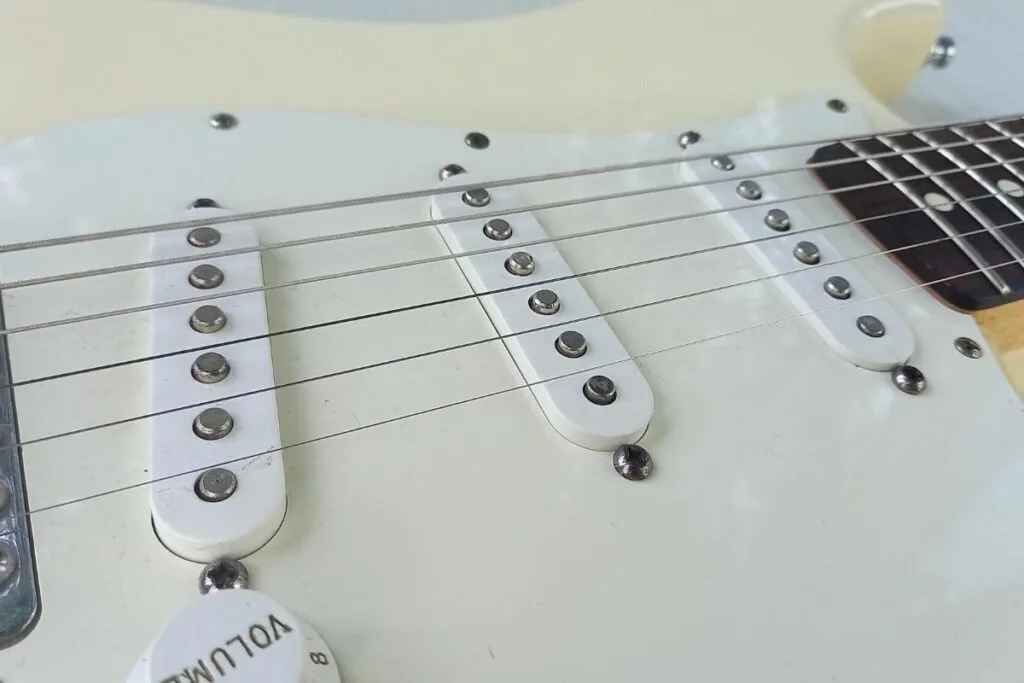
Once this starts happening, there’s no fixing it. Instead, it’s time to restring your guitar with a fresh set.
Personally, I think it’s helpful to know when to change your strings to make sure they don’t get to the stage where they’re failing to stay in tune!
Some of the causes of string aging, like rusting, can be prevented by cleaning your guitar strings before and after playing.
New guitar strings
On the other end of the spectrum, new guitar strings also have problems with holding the right tuning – but for different reasons. If you’ve ever strung up a new guitar, you’ll know the painstaking song-and-dance of tuning up, playing something, and then immediately having to retune!
Fresh guitar strings need time to fully stretch out and settle – along with your guitar bridge and neck – before they can reliably hold their tuning.
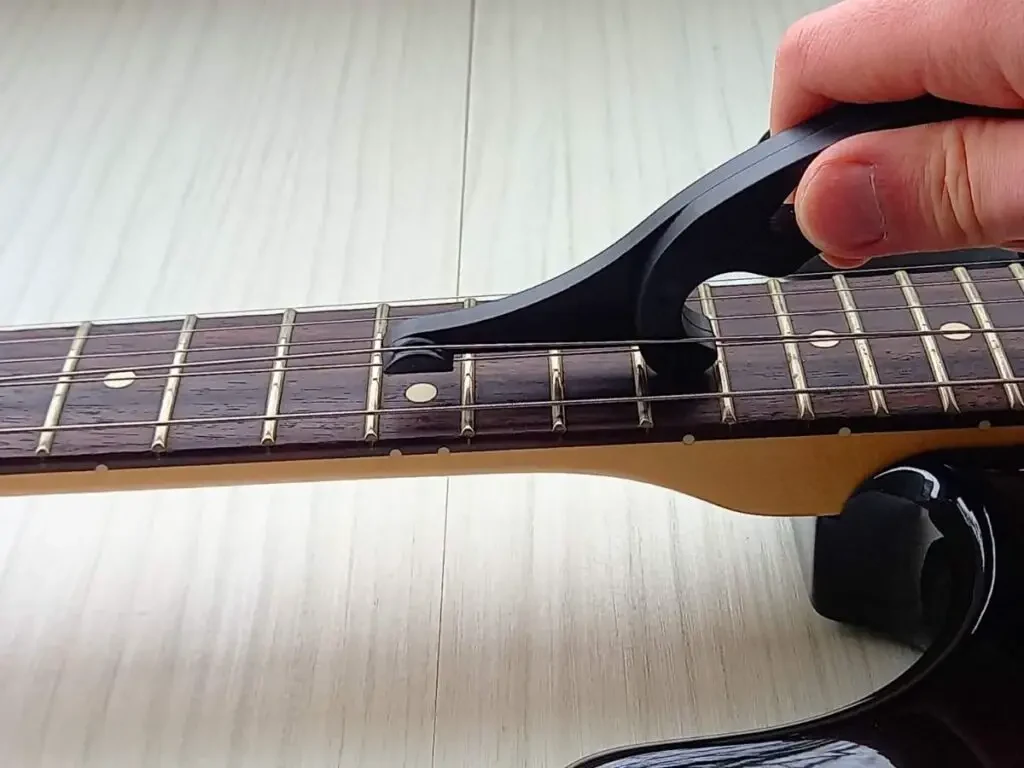
You can actually speed this process up by stretching your guitar strings. I’ve found that it only takes a few rounds of stretching for my guitar and strings to fully settle.
If you don’t stretch your strings, then they should only slip out of tune for a few hours – and maybe even over the first night. If they’re still not holding their tune after that, then it’ll likely be caused by something else.
Poorly installed strings
Even if you’ve swapped out your old set and fully stretched them – your guitar strings can still go out of tune if they’ve not been installed properly.
Having too many windings on the tuning pegs or any slack at the bridge can cause the string to slip – taking your tuning with it.
I’ve covered this fully in my step-by-step restringing guide, but I find that two or three windings at the tuning post is enough.
Interestingly, some big names in the industry like Fender swear against having the string overlap at the tuning post (as in this video). To be honest, I’ve never had a problem with overlapping the string once. I’d always heard that it locks the string in place to hold the tuning better – and it’s always worked for me!
I agree, however, that too many overlaps can cause room for slippage and increases the risk of breaking from friction.
Poor quality strings
Finishing the theme of strings, using cheap strings can be to blame for your tuning woes. You might be saving a couple of dollars, but cheaper strings will be made with poorer quality materials and with less quality control processes.
I remember trying out an unfamiliar brand and was disappointed when the string wouldn’t hold its tuning. After a few retunes, it turned out that the string was literally starting to unwind and fall apart at the ball end!
I have a guide on what I think are the best guitar strings, but you can’t go wrong with buying from a reputable name brand.
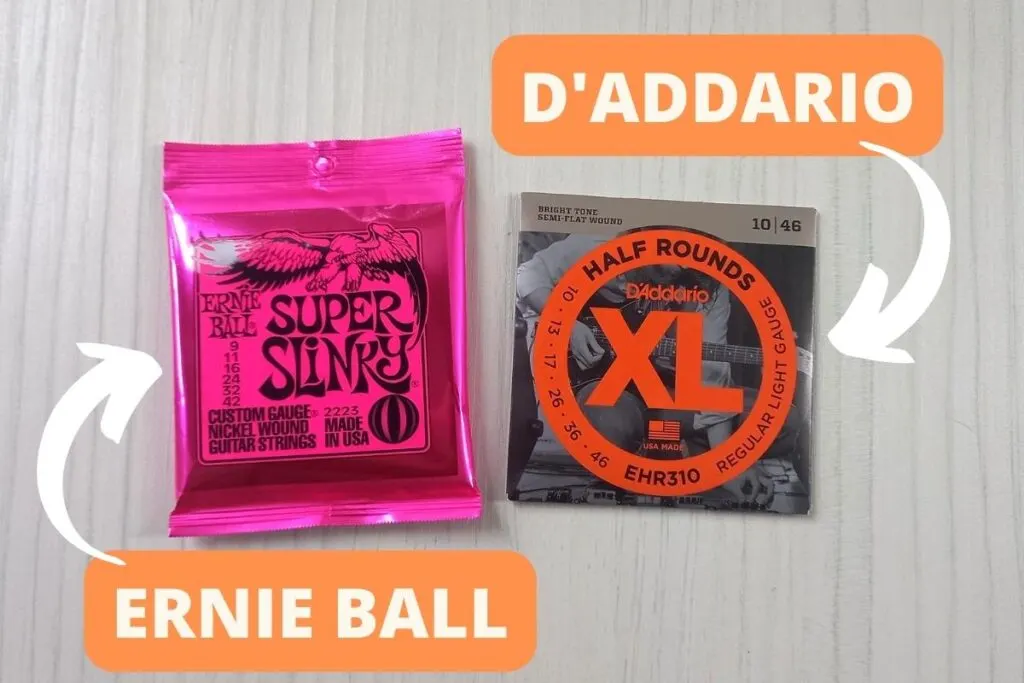
Ernie Ball and D’Addario are the market leaders, and I can vouch for them as a regular user of both. But, there’s plenty of alternatives too. Just make sure to do your research! You know what they say: buy cheap, buy twice!
Bad intonation
Your guitar strings might be in-tune, but your guitar can still be out of tune. This might sound like some kind of riddle, but it isn’t. If your guitar isn’t properly intonated, then the notes you play might be out of tune.
Your guitar’s intonation is how “in-tune” it is across the entire fretboard. Playing a note should be in tune whether you’re playing it at the top or bottom of the fretboard.
A quick way to check your guitar’s intonation is to play an open string, and then play the 12th fret of that string. They should be the same note (albeit an octave apart). If there’s a difference, then your guitar’s intonation is wrong.
But, don’t worry – this is actually really easy to fix! I’ve done it on all my guitars and it takes about 30 minutes max. I’m sure I’ll write a guide on it at some point, but in the meantime check out this good guide from Sweetwater.
The important thing, as they say in the article, is to be careful not to strip the screwheads. Use a well fitted screwdriver for the saddles, and take your time!
Changes in temperature
You might not think it, but temperature and humidity can have a big impact on your guitar.
Changes in the ambient climate can cause the wood in your guitar to expand and contract which changes the string tension – thus changing their pitch. Likewise, humidity can also cause your strings to rust, taking us back to the first item in this list!
The best way to avoid this is knowing how to store your guitar. In a perfect world, you should keep your guitar at a consistent temperature and humidity. Some tips include keeping the room heated and cooled at appropriate times of year, and to keep your guitar away from windows and outside facing walls.
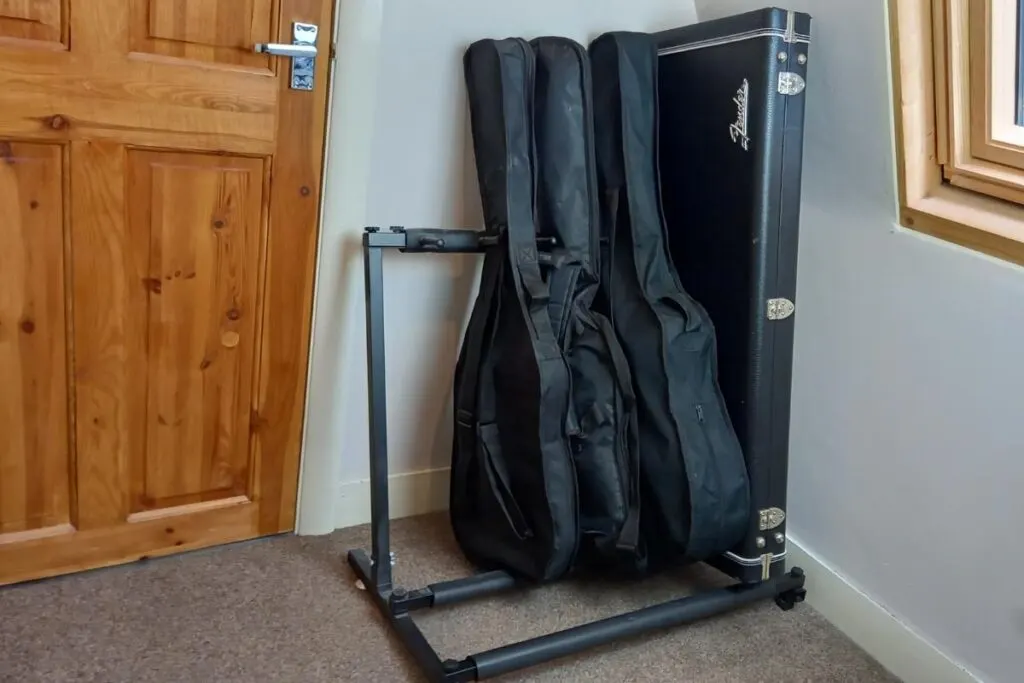
If you’re like me and can’t really do much (small house with sub-par heating!) then a helpful tip that I’ve found to prevent the effects is by keeping your guitar in its case between playing. Now, this won’t stop the effects completely, but it’ll act as a buffer and help reduce the effects of sudden changes in temperature or humidity.
Nut problems
Your guitar’s nut is the little block where the strings rest between the headstock and fretboard. If the nut becomes damaged, or deformed, it can affect your strings tuning (and intonation!).
If the nut is too tight then the string can snag and not pass through smoothly. This is more of a problem if you’ve gone up a string gauge to thicker strings, or if you have a cheaper nut.
One way to help with this is to properly lubricate your nut (and your saddles while you’re at it). Rubbing the tip of a pencil in the nut slots deposits a small amount of graphite that helps your string to move smoothly. Not only will this help with tuning, but it’ll help against your strings breaking.
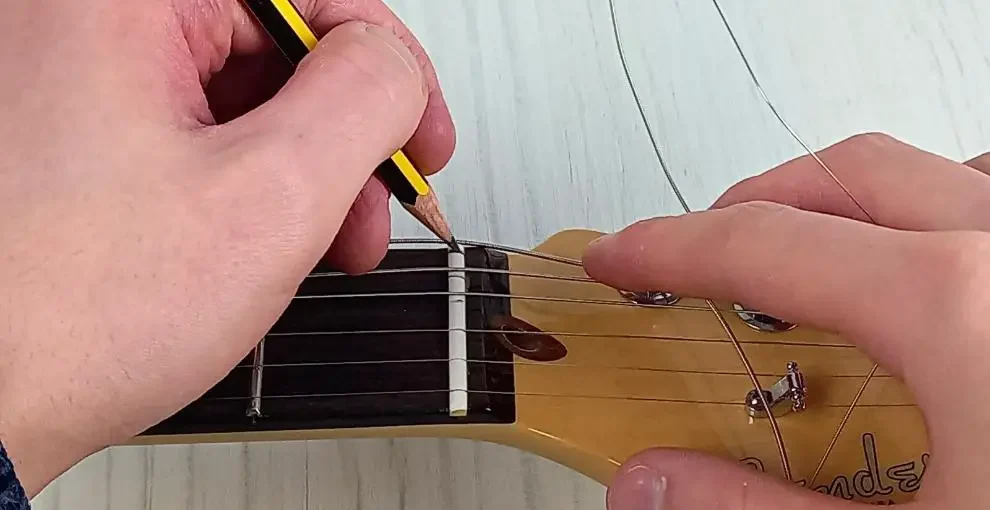
But, if your guitar’s nut is damaged beyond repair (like one of mine currently is…) then you can get it replaced. It’s actually one of the cheaper modifications you can make to your guitar, coming in at around $50 to $75.
Damaged tuners
Tuning pegs do a lot of heavy lifting, putting up with constant tension from your strings digging into them. Over time, they can become worn which creates an uneven surface for your strings. Like the nut, this can cause the strings to snag and catch – or move unevenly – which spells trouble for your tuning.
If you suspect your tuning pegs might be faulty, then inspect your tuners for obvious damage or rough patches. You should be able to get them buffed out by a professional at your local guitar store.
If the damage is too severe (which is more likely with cheaper tuners) then you might have to swap them out for completely new tuners. It’s a little bit of a pain but, in the long run, this will make your guitar sound better!
Bad quality tuner
Perhaps you’ve tuned your guitar, it’s perfectly intonated, but it still sounds off tune. It could be your tuner that’s to blame.
There’s a lot of different types of tuner out there. Some are better than others. In my experience, cheaper guitar tuners tend to have a wider tolerance for what is “in-tune” – which isn’t good.
Ideally, you’ll want to make sure your tuner has a tolerance as close to zero “cent” as possible. A cent is basically the micro pitches between musical notes. My Boss TU-2 pedal has a tolerance of +/- 3 cents, and I can’t hear any problems once my guitars are fully in-tune.

If you only tune by ear, then it might be time to pick up an electronic tuner. Tuning by ear is probably the least accurate way to tune your guitar and could be the reason something sounds off!
Pickup height
This is an unlikely one, but if your pickups are too high, then it can affect your tuning. Your guitar pickups contain magnets that are essential to how they work.
If these magnets are too close to the strings, they can actually pull the strings closer when you play, making your guitar out of tune.
The exact distance your pickups should be varies across the different pickup types and models of guitar. Guitar pickup manufacturer Seymour Duncan recommends starting at 3/32nds of an inch. Mine are set up somewhere around that height, and I haven’t had any problems with them!
Floating bridge
Some guitars come with what’s known as a “floating bridge” meaning that the bridge can move up or down. They’re most often called “vibrato systems” (often misnomered as a “tremolo” system).
The tension from your strings holds a floating bridge in place. So, if any string changes length then it’ll cause all the other strings to fall out of tune.
Personally, I don’t like floating bridges, so I’ve “decked” my bridges meaning that they sit flush against the guitar’s body, meaning it only moves in one direction. It’s a really simple DIY fix that you can check out here.
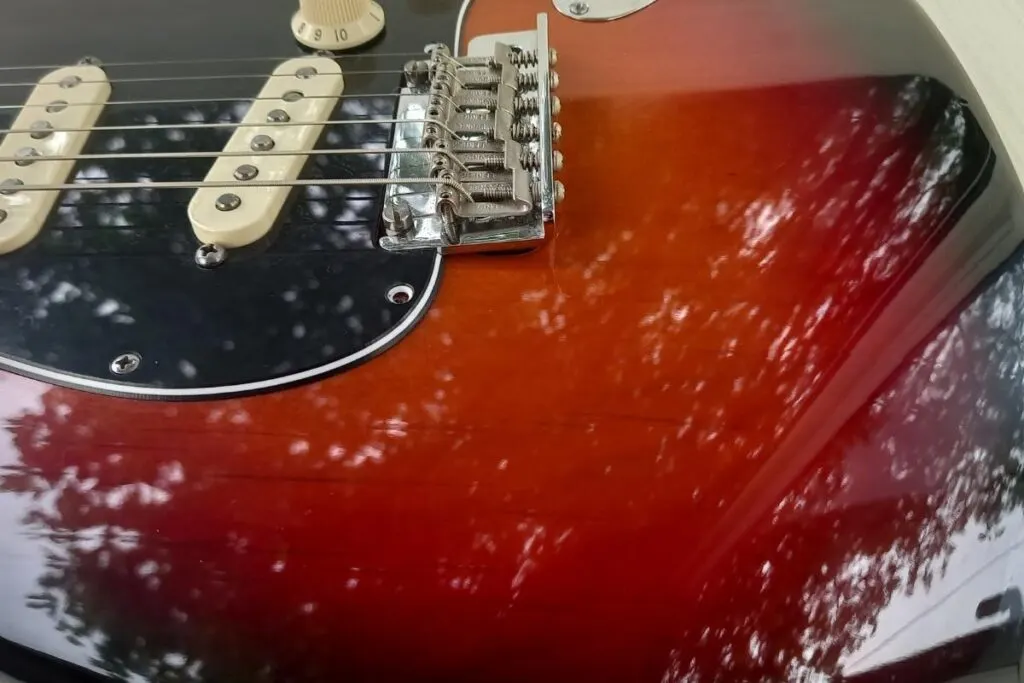
Otherwise, if you like using a floating bridge, you might want to look into getting a locking nut installed. These clamp your guitar strings in place at the nut, which keep them from slipping out of tune when using the tremolo bar. This will be quite a pricey job though – so think it over first.
Playing technique
How you play your guitar can affect how well it stays in-tune. Heavy handed playing, like hard strumming, picking, and big bends can easily pull your strings out of tune.
A light touch is all that’s needed when playing guitar. You can see this when using a tuner. Try fretting a note, then pressing really hard and playing it again. The note will be sharper, as you’re pulling the string tighter.
To fix this, you’ll need to slightly change the way you play – it takes some practice but it is doable. I’ve done it myself with changing how I fret notes.
Try taking a couple of steps back and practicing some songs with the correct technique. Check out a YouTube video, or even get some in person lessons to help correct where you’re going wrong!
Capo placement
Using a capo is a really useful way to quickly change tuning, but if it’s installed wrong then it can make your tuning wrong.
When using a capo, make sure that it’s clamped straight and even, running parallel to the metal fret wire. This ensures that all the strings have an equal amount of pressure against the fret and ensures an even tuning.
It could even be a problem with your capo itself. I use a toggle capo, and have found it to be pretty hit-or-miss. You might want to invest in a better quality capo that can apply a nice, even pressure to your strings.
Knocks and bumps
If your guitar gets knocked or bumped, then it can easily fall out of tune. Taking your guitar on the road, or keeping it in a high traffic area can easily cause some unwanted knocks.
Ideally, you should store your guitar somewhere away from high traffic areas (including pets, which can easily bash into things with no regard!).
If you’re on the road, then keep your guitar secure in a hard case, held securely in place – ideally on its side, like a briefcase. But, if it’s likely to fall, then it’s better to keep it laid down flat.
I suggest keeping your guitar in a hard-case or loose fitting gig bag between playing. Why? Because I’ve recently noticed that one of my tighter fitting cases has been pulling on my guitar tuners, pulling my top strings out of tune!
Final thoughts
There’s a lot of different reasons that your guitar might fall out of tune. Finding the route cause is essential to getting a solid, stable tuning that you can rely on.
In my experience, it’s usually a combination of little things that causes your guitar to go out of tune. The most common usually being old strings, temperature changes, or poor intonation.
But, if you suspect it to be something more serious causing your tuning problems – or just can’t find out what the source is – then I recommend taking your guitar to your local guitar store.

Conor is a music producer, multi-instrumentalist, and all-round enthusiast from the UK with over 15 years of experience. He’s the founder and sole-content creator for the roundtable audio blog and YouTube channel.
